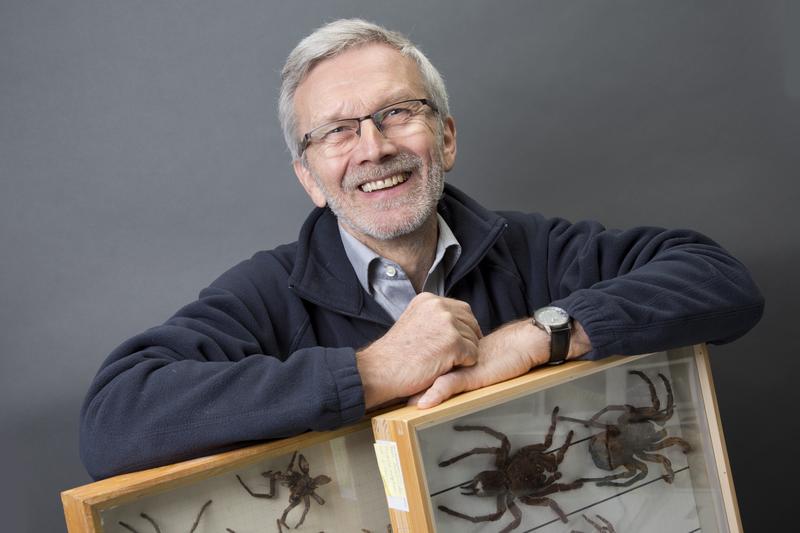Bern-based initiative to investigate the full extent of spider diversity within 30 years
In a project as ambitious as it is unusual, 34 research partners have recently come together in an initiative to record 95% of the world's spider species within the next 30 years. The idea is the brainchild of Bern-based Professor Wolfgang Nentwig, with the Natural History Museum Bern also playing a central role in the establishment of a virtual research institute. The initiative, which will break new ground in biodiversity re-search, is now on the lookout for funding.
It has taken humankind 250 years to describe 46 000 species of spider. An initiative based in Bern (Switzerland) now wants to record all the remaining species within the next 30 years. According to Professor Wolfgang Nentwig from the Institute of Ecology and Evolution at the University of Bern, scientists believe that only "around half of spider species have been discovered to date".
Nentwig is the man behind an unconventional initiative, the Association for the Promotion of Spider Research, which was set up in June 2016. The 34 founding partners include natural history museums, universities and other research institutes from all over the world. Together, they have set up the Virtual Institute of Spider Taxonomic Research - a model almost unheard of in the academic world.
Spiders - unpopular but important
"Efforts to protect biodiversity must be speeded up urgently", warns Nentwig, meaning that the need for innovative ideas is great. Taxonomic research is the first step towards biodiversity protection as it permits the identification of biodiversity hotspots, which in turn can form the focus of conservation efforts. A similar project, from which Nentwig drew his inspiration, was set up several decades ago to investigate the Wallace Line, a taxonomically significant biogeographical line between Asia and Australia. Though the ultimate aim of the initiative at hand is to protect biodiversity as a whole, the researchers are, for good reason, concentrating on spiders. "Limiting the focus in this way makes sense as the conditions surrounding research into spider taxonomy are, globally speaking, uniquely favourable." Nentwig cites a large community of excellent scientists, an exhaustive reference database of nomenclature information and an online collection of all the taxonomic literature which has been published since the establishment of the classification system in 1757.
This is where the Natural History Museum Bern comes in. The institution operates the World Spider Catalog, a fully searchable online resource which makes complete taxonomic data for all validated spider species freely available to its 3000 registered users. The Catalog, which is made possible by Swiss legislation, represents a landmark in science policy and was recently described in the renowned journal "Nature" as an "invaluable model for the rapid delivery of taxonomic data". Critically, the Spider Catalog affords researchers from developing countries access to scientific literature, which is essential if the spider initiative is to achieve its ambitious goal. There is still much to be discovered in developing regions, especially South and Latin America, Africa and India.
Experts estimate that up to 120 000 spider species exist worldwide. Spiders occur in all mainland ecosystems in high densities and are key components of these networks. As predators, they have an important regulatory function in natural insect control and are beneficial organ-isms for agriculture. Though not typically beloved of people, their dubious reputation is, ob-jectively speaking, unjustified.
Sponsors needed
The main aim of the Virtual Institute is to support young scientists such as PhD students and post-docs by providing grants to allow them to undertake taxonomic research. Grants will be awarded by an international group of voluntary directors elected from among the partners.
First of all, however, the Institute itself needs funding. The initiators have calculated that 30 million Swiss francs will be required to meet the project's bold targets. However, "because of the innovative nature of the research initiative, we don't meet the criteria for standard funding instruments." As a result, the initiative is turning to private individuals, foundations, busi-ness and industry to look for sponsoring.
Contact:
Prof. Dr. Wolfgang Nentwig, Institute of Ecology and Evolution, University of Bern, wolf-gang.nentwig at iee.unibe.ch
Prof. Dr. Christian Kropf, Invertebrate Department, Naturhistorisches Museum der Burger-gemeinde Bern, christian.kropf at nmbe.ch
Weitere Informationen:
http://www.vinst.org
Die semantisch ähnlichsten Pressemitteilungen im idw


